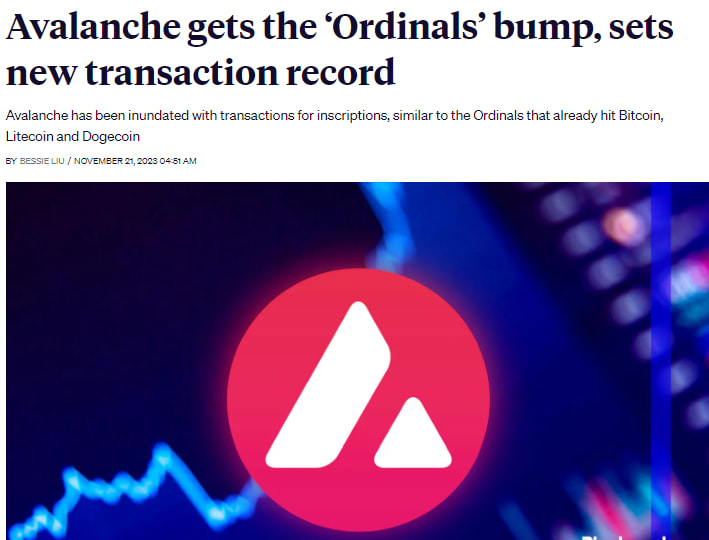Unraveling the Avalanche Surge: Decoding the Dynamics Between JP Morgan's Leverage and Inscriptions
This week, Avalanche (AVAX) continue its rise following amazing news.
On the one hand, banking giant J.P. Morgan used its blockchain to tokenize wallets. J.P. Morgan's Onyx used a subnetwork of Avalanche, or a dedicated version of the blockchain, in a proof of concept with Apollo Global and the Monetary Authority of Singapore's Project Guardian.
On the other hand, a new brand of crypto collectibles — similar to Bitcoin Ordinals — has apparently hit Avalanche, and it’s responsible for more than 95% of its daily on-chain transactions.
The transaction count on Avalanche’s C-Chain (responsible for handling smart contracts) over the past week has set new all-time highs, reaching an estimated 2.3 million transactions per day on November 19. Avalanche has historically seen around 450 thousand per day on average.
Like Bitcoin Ordinals, Avalanche’s “ASC-20” tokens use inscription to put information onto a blockchain, Jacob Everly, a technical product manager at Ava Lab, told Blockworks.

In light of this groundbreaking news, we are poised to delve into an in-depth investigation regarding the potential impact of this news on the Avalanche ecosystem and its primary activities. Our objective is to gauge the ripple effects within the Avalanche network, tracking key metrics and indicators that reflect the ecosystem's response to this transformative development.
To conduct this analysis, we will leverage on-chain data from Flipside Crypto, a reliable source that provides comprehensive insights into blockchain metrics. Specifically, we will monitor recent transactions, identifying any notable spikes or fluctuations in transaction volumes. Transaction throughput, measured in transactions per second (TPS), will be a key metric to assess the network's capacity and responsiveness during this period of heightened interest and activity.
Additionally, we will closely examine user engagement within the Avalanche ecosystem. This includes tracking the number of active users, observing any significant increases or shifts in user behavior. Furthermore, we will explore data related to new user adoption, aiming to understand whether this collaboration has attracted a surge in participation and interest among new users.
Our analysis will extend beyond transactional data to encompass the broader impact on the Avalanche network's infrastructure. We will investigate any adjustments in network dynamics, including changes in mining activity, validator behavior, and overall network stability.
By employing Flipside Crypto's robust on-chain data analytics, we aim to provide a comprehensive and data-driven assessment of how this collaboration is influencing the Avalanche ecosystem. This investigation will shed light on the network's resilience, user response, and overall health in the wake of this significant development in the financial services sector. Stay tuned for detailed insights and a nuanced understanding of the real-time implications within the Avalanche blockchain ecosystem.
As I commented earlier this Thursday, Avalanche (AVAX) continued its rise following news that banking giant J.P. Morgan used its blockchain to tokenize wallets. J.P. Morgan's Onyx used a subnetwork of Avalanche, or a dedicated version of the blockchain, in a proof of concept with Apollo Global and the Monetary Authority of Singapore's Guardian Project. According to the graphs we can see that over the last month, daily transactions have increased by 3000%, and in particular, by 2300 in the last week. We can see that most of them come from new users, which makes us think that this news has a very special relevance. This tells us that during the last month more than 100 million transactions have been executed. We must also take into account that the fees are not very altered, since the values seem to have risen a little, but we can see that in the last few days, since the big rise, they have decreased.
As can be seen in these graphs, transactions per second have also increased significantly, from less than 3 in October to more than 60 today. The same happens with the transactions made per block, which also increase dramatically, from a minimum of 5 to more than 130. Finally, in relation to the time between blocks, we can see that they have been decreasing for some time and continue with this trend, adjusting the value to seconds per block.
-
Dominant Influence of Inscriptions: The significant increase in Avalanche activity is primarily attributed to a surge in Inscription-related transactions. A noteworthy proportion, exemplified by 6 million out of 6.3 million transactions yesterday, is directly linked to Inscriptions.
-
General Activity Increase: While the surge in Inscriptions is substantial, there is a general uptrend in activity. However, this overall increase is comparatively modest when excluding the impact of Inscriptions.
-
Moderate User Impact: In terms of user engagement, the impact is moderate, with Inscriptions representing 10,000 transactions out of a user base of less than 50,000.
-
Transaction Volume and Fee Dynamics: The high volume of transactions associated with Inscriptions is causing a notable rise in average transaction fees. Interestingly, despite the overall fee increase, transactions specifically related to Inscriptions seem to incur lower fees.
Another different thing is the case of users, where we note that during the last few days have also increased more than 20%, totaling more than 14 million active users during the last month.
In this case, the impact has not been as pronounced as previously mentioned, but we can see that uptrend, which started in October, continues to grow, going from 20K to 50K active users per day.

The significant surge appears to be primarily driven by a notable increase in Inscription activity. For instance, as of yesterday, 6 million out of 6.3 million transactions were attributed to Inscriptions.
Despite the rise in general activity, it has been noted that the overall increase is comparatively modest, excluding the impact of Inscriptions.
In terms of users, the impact is relatively moderate, with Inscriptions accounting for 10,000 out of a user base of less than 50,000.
Furthermore, the substantial number of transactions resulting from Inscriptions is contributing to an upswing in average transaction fees. Interestingly, it appears that fees for Inscription transactions are lower despite the overall increase.